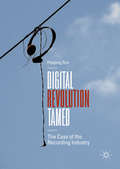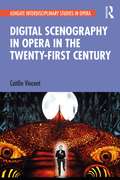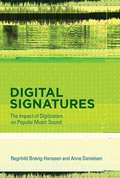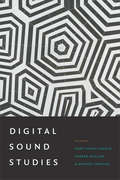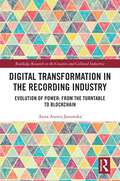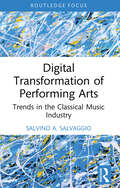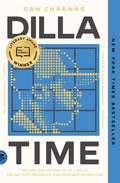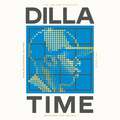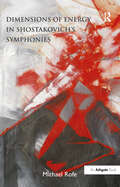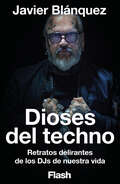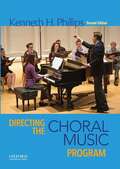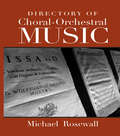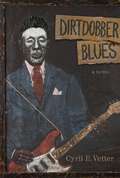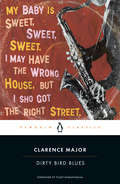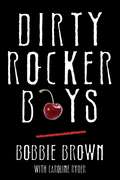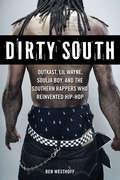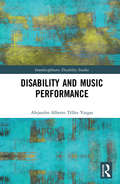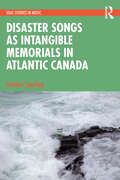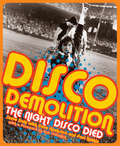- Table View
- List View
Digital Music Videos
by Steven ShaviroMusic videos today sample and rework a century’s worth of movies and other pop culture artifacts to offer a plethora of visions and sounds that we have never encountered before. As these videos have proliferated online, they have become more widely accessible than ever before. In Digital Music Videos, Steven Shaviro examines the ways that music videos interact with and change older media like movies and gallery art; the use of technologies like compositing, motion control, morphing software, and other digital special effects in order to create a new organization of time and space; how artists use music videos to project their personas; and how less well known musicians use music videos to extend their range and attract attention. Surveying a wide range of music videos, Shaviro highlights some of their most striking innovations while illustrating how these videos are creating a whole new digital world for the music industry.
Digital Revolution Tamed: The Case of the Recording Industry
by Hyojung SunThis book explores why widespread predictions of the radical transformation in the recording industry did not materialise. Although the growing revenue generated from streaming signals the recovery of the digital music business, it is important to ask to what extent is the current development a response to digital innovation. Hyojung Sun finds the answer in the detailed innovation process that has taken place since Napster. She reassesses the way digital music technologies were encultured in complex music valorisation processes and demonstrates how the industry has become reintermediated rather than disintermediated. This book offers a new understanding of digital disruption in the recording industry. It captures the complexity of the innovation processes that brought about technological development, which arose as a result of interaction across the circuit of the recording business – production, distribution, valorisation, and consumption. By offering a more sophisticated account than the prevailing dichotomy, the book exposes deterministic myths surrounding the radical transformation of the industry.
Digital Scenography in Opera in the Twenty-First Century (Ashgate Interdisciplinary Studies in Opera)
by Caitlin VincentDigital Scenography in Opera in the Twenty-First Century is the first definitive study of the use of digital scenography in Western opera production. The book begins by exploring digital scenography’s dramaturgical possibilities and establishes a critical framework for identifying and comparing the use of digital scenography across different digitally enhanced opera productions. The book then investigates the impacts and potential disruptions of digital scenography on opera’s longstanding production conventions, both on and off the stage. Drawing on interviews with major industry practitioners, including Paul Barritt, Mark Grimmer, Donald Holder, Elaine J. McCarthy, Luke Halls, Wendall K. Harrington, Finn Ross, S. Katy Tucker, and Victoria ‘Vita’ Tzykun, author Caitlin Vincent identifies key correlations between the use of digital scenography in practice and subsequent impacts on creative hierarchies, production design processes, and organisational management. The book features detailed case studies of digitally enhanced productions premiered by Dutch National Opera, Komische Oper Berlin, Opéra de Lyon, The Royal Opera, Covent Garden, San Francisco Opera, Santa Fe Opera, Théâtre Royal de la Monnaie, The Metropolitan Opera, Victorian Opera, and Washington National Opera.
Digital Signatures: The Impact of Digitization on Popular Music Sound
by Anne Danielsen Ragnhild Brøvig-HanssenIs digital production killing the soul of music? Is Auto-Tune the nadir of creative expression? Digital technology has changed not only how music is produced, distributed, and consumed but also -- equally important but not often considered -- how music sounds. In this book, Ragnhild Brøvig-Hanssen and Anne Danielsen examine the impact of digitization on the aesthetics of popular music. They investigate sonically distinctive "digital signatures" -- musical moments when the use of digital technology is revealed to the listener. The particular signatures of digital mediation they examine include digital reverb and delay, MIDI and sampling, digital silence, the virtual cut-and-paste tool, digital glitches, microrhythmic manipulation, and autotuning -- all of which they analyze in specific works by popular artists.Combining technical and historical knowledge of music production with musical analyses, aesthetic interpretations, and theoretical discussions, Brøvig-Hanssen and Danielsen offer unique insights into how digitization has changed the sound of popular music and the listener's experience of it. For example, they show how digital reverb and delay have allowed experimentation with spatiality by analyzing Kate Bush's "Get Out of My House"; they examine the contrast between digital silence and the low-tech noises of tape hiss or vinyl crackle in Portishead's "Stranger"; and they describe the development of Auto-Tune -- at first a tool for pitch correction -- into an artistic effect, citing work by various hip-hop artists, Bon Iver, and Lady Gaga.
Digital Signatures: The Impact of Digitization on Popular Music Sound (The\mit Press Ser.)
by Anne Danielsen Ragnhild Brovig-HanssenHow sonically distinctive digital “signatures”—including reverb, glitches, and autotuning—affect the aesthetics of popular music, analyzed in works by Prince, Lady Gaga, and others. Is digital production killing the soul of music? Is Auto-Tune the nadir of creative expression? Digital technology has changed not only how music is produced, distributed, and consumed but also—equally important but not often considered—how music sounds. In this book, Ragnhild Brøvig-Hanssen and Anne Danielsen examine the impact of digitization on the aesthetics of popular music. They investigate sonically distinctive “digital signatures”—musical moments when the use of digital technology is revealed to the listener. The particular signatures of digital mediation they examine include digital reverb and delay, MIDI and sampling, digital silence, the virtual cut-and-paste tool, digital glitches, microrhythmic manipulation, and autotuning—all of which they analyze in specific works by popular artists.Combining technical and historical knowledge of music production with musical analyses, aesthetic interpretations, and theoretical discussions, Brøvig-Hanssen and Danielsen offer unique insights into how digitization has changed the sound of popular music and the listener's experience of it. For example, they show how digital reverb and delay have allowed experimentation with spatiality by analyzing Kate Bush's “Get Out of My House”; they examine the contrast between digital silence and the low-tech noises of tape hiss or vinyl crackle in Portishead's “Stranger”; and they describe the development of Auto-Tune—at first a tool for pitch correction—into an artistic effect, citing work by various hip-hop artists, Bon Iver, and Lady Gaga.
Digital Sound Studies
by Mary Caton Lingold Darren Mueller Whitney TrettienThe digital turn has created new opportunities for scholars across disciplines to use sound in their scholarship. This volume’s contributors provide a blueprint for making sound central to research, teaching, and dissemination. They show how digital sound studies has the potential to transform silent, text-centric cultures of communication in the humanities into rich, multisensory experiences that are more inclusive of diverse knowledges and abilities. Drawing on multiple disciplines—including rhetoric and composition, performance studies, anthropology, history, and information science—the contributors to Digital Sound Studies bring digital humanities and sound studies into productive conversation while probing the assumptions behind the use of digital tools and technologies in academic life. In so doing, they explore how sonic experience might transform our scholarly networks, writing processes, research methodologies, pedagogies, and knowledges of the archive. As they demonstrate, incorporating sound into scholarship is thus not only feasible but urgently necessary. Contributors. Myron M. Beasley, Regina N. Bradley, Steph Ceraso, Tanya Clement, Rebecca Dowd Geoffroy-Schwinden, W. F. Umi Hsu, Michael J. Kramer, Mary Caton Lingold, Darren Mueller, Richard Cullen Rath, Liana M. Silva, Jonathan Sterne, Jennifer Stoever, Jonathan W. Stone, Joanna Swafford, Aaron Trammell, Whitney Trettien
Digital Transformation in The Recording Industry: Evolution of Power: From The Turntable To Blockchain (Routledge Research in the Creative and Cultural Industries)
by Anna Anetta JanowskaThe recording industry has famously been transformed by technology throughout its entire history.The book presents an analysis of these changes using Porter's five forces model. The author highlights the evolution of buyers' and suppliers' power, the emergence of new competitors, product innovation and rivalry between companies in the industry driven by economic, political, social and legal factors.As an early mover in the social diffusion of copyright-sensitive content, the recording industry reflected in this book serves as an important reference for the analysis of other cultural and creative sectors.
Digital Transformation in the Recording Industry: Evolution of Power: From The Turntable To Blockchain (Routledge Research in the Creative and Cultural Industries)
by Anna Anetta JanowskaThe recording industry has famously been transformed by technology throughout its entire history. The book presents an analysis of these changes using Porter's five forces model. The author highlights the evolution of buyers' and suppliers' power, the emergence of new competitors, product innovation and rivalry between companies in the industry driven by economic, political, social and legal factors. As an early mover in the social diffusion of copyright-sensitive content, the recording industry reflected in this book serves as an important reference for the analysis of other cultural and creative sectors.
Digital Transformation of Performing Arts: Trends in the Classical Music Industry (Routledge Focus on Business and Management)
by Salvino A. SalvaggioIn the wake of the COVID-19 pandemic, a combination of hybrid working and cultural consumption, alongside shifting audience tastes, performing arts organisations are dealing with significant challenges around digital transformation (DT). This book explores the DT of performing arts, taking readers on a journey through classical orchestras as illustrative examples.From reimagining audience engagement to revolutionising operations, the book examines how emerging technologies like AI, VR, and blockchain are reshaping the cultural landscape. Through case studies of successful digital initiatives and analysis of critical success factors, readers will gain practical strategies for navigating this complex transition. The author emphasises that successful DT hinges on a clear, comprehensive strategy and a sharp implementation roadmap. Key challenges addressed include balancing tradition with innovation, ethical considerations, and financial sustainability. Notably, the book features numerous summary tables that serve as actionable templates, providing readers with ready-to-use tools to support their own DT efforts. With a forward-looking perspective, the book also explores future trends and research directions.This concise book synthesises fragmented research and practical insights to provide a readable overview for scholars, students, and reflective practitioners. It will also be of value for arts administrators, performers, and cultural policymakers across various disciplines.
Dilla Time: The Life and Afterlife of J Dilla, the Hip-Hop Producer Who Reinvented Rhythm
by Dan CharnasA NEW YORK TIMES BEST SELLER"This book is a must for everyone interested in illuminating the idea of unexplainable genius.” —QUESTLOVEEqual parts biography, musicology, and cultural history, Dilla Time chronicles the life and legacy of J Dilla, a musical genius who transformed the sound of popular music for the twenty-first century.He wasn’t known to mainstream audiences, even though he worked with renowned acts like D’Angelo and Erykah Badu and influenced the music of superstars like Michael Jackson and Janet Jackson. He died at the age of thirty-two, and in his lifetime he never had a pop hit. Yet since his death, J Dilla has become a demigod: revered by jazz musicians and rap icons from Robert Glasper to Kendrick Lamar; memorialized in symphonies and taught at universities. And at the core of this adulation is innovation: a new kind of musical time-feel that he created on a drum machine, but one that changed the way “traditional” musicians play.In Dilla Time, Dan Charnas chronicles the life of James DeWitt Yancey, from his gifted childhood in Detroit, to his rise as a Grammy-nominated hip-hop producer, to the rare blood disease that caused his premature death; and follows the people who kept him and his ideas alive. He also rewinds the histories of American rhythms: from the birth of soul in Dilla’s own “Motown,” to funk, techno, and disco. Here, music is a story of Black culture in America and of what happens when human and machine times are synthesized into something new. Dilla Time is a different kind of book about music, a visual experience with graphics that build those concepts step by step for fans and novices alike, teaching us to “see” and feel rhythm in a unique and enjoyable way.Dilla’s beats, startling some people with their seeming “sloppiness,” were actually the work of a perfectionist almost spiritually devoted to his music. This is the story of the man and his machines, his family, friends, partners, and celebrity collaborators. Culled from more than 150 interviews about one of the most important and influential musical figures of the past hundred years, Dilla Time is a book as delightfully detail-oriented and unique as J Dilla’s music itself.
Dilla Time: The Life and Afterlife of J Dilla, the Hip-Hop Producer Who Reinvented Rhythm
by Dan Charnas'This book is a must for everyone interested in illuminating the idea of unexplainable genius' - QUESTLOVEEqual parts biography, musicology, and cultural history, Dilla Time chronicles the life and legacy of J Dilla, a musical genius who transformed the sound of popular music for the twenty-first century.He wasn't known to mainstream audiences, and when he died at age thirty-two, he had never had a pop hit. Yet since his death, J Dilla has become a demigod, revered as one of the most important musical figures of the past hundred years. At the core of this adulation is innovation: as the producer behind some of the most influential rap and R&B acts of his day, Dilla created a new kind of musical time-feel, an accomplishment on a par with the revolutions wrought by Louis Armstrong and James Brown. Dilla and his drum machine reinvented the way musicians play.In Dilla Time, Dan Charnas chronicles the life of James DeWitt Yancey, from his gifted Detroit childhood to his rise as a sought-after hip-hop producer to the rare blood disease that caused his premature death. He follows the people who kept Dilla and his ideas alive. And he rewinds the histories of American rhythms: from the birth of Motown soul to funk, techno, and disco. Here, music is a story of what happens when human and machine times are synthesized into something new.This is the story of a complicated man and his machines; his family, friends, partners, and celebrity collaborators; and his undeniable legacy. Based on nearly two hundred original interviews, and filled with graphics that teach us to feel and "see" the rhythm of Dilla's beats, Dilla Time is a book as defining and unique as J Dilla's music itself.Financial Times Music Book of the Year 2022
Dimensions of Energy in Shostakovich's Symphonies
by Michael RofeShostakovich's music is often described as being dynamic, energetic. But what is meant by 'energy' in music? After setting out a broad conceptual framework for approaching this question, Michael Rofe proposes various potential sources of the perceived energy in Shostakovich's symphonies, describing also the historical significance of energeticist thought in Soviet Russia during the composer's formative years. The book is in two parts. In Part I, examples are drawn from across the symphonies in order to demonstrate energy streams within various musical dimensions. Three broad approaches are adopted: first, the theories of Boleslav Yavorsky are used to consider melodic-harmonic motion; second, Boris Asafiev's work, with its echoes of Ernst Kurth, is used to describe form as a dynamic process; and third, proportional analysis reveals numerous symmetries and golden sections within local and large-scale temporal structures. In Part II, the multi-dimensionality of musical energy is considered through case studies of individual movements from the symphonies. This in turn gives rise to broader contextualised perspectives on Shostakovich's work. The book ends with a detailed examination of why a piece of music might contain golden sections.
Dioses del Techno: Retratos delirantes de los DJs de nuestra vida (Flash Relatos #Volumen)
by Javier BlánquezUn repaso a las intensas vidas de los DJs más legendarios de nuestros tiempos. Dioses del techno es una compilación de textos en clave satírica que giran alrededor de las vidas de los quince DJs -más unbonus track dedicado a Pocholo- más icónicos y carismáticos de nuestra época: Carl Cox, Sven Väth, Richie Hawtin, Nina Kraviz o Jeff Mills, además del portero más temido del mundo, Sven Marquardt. <P><P>A finales de 2015, Javier Blánquez comenzó a publicar estos perfiles en la revista digital Beatburguer, y tuvieron miles de visitas. Blánzquez no buscaba describir a estas figuras en términos académicos o muy técnicos, sino que intentó descubrir en cada artista las anécdotas más disparatadas, los detalles más escabrosos de sus vidas y los rasgos que, en definitiva, los han hecho únicos. El resultado son unas historias desternillantes que destapan todos los excesos de estos mitos, pero también su absoluta dedicación a la música de baile. <P><P>Ahora, por primera vez, el autor reúne la serie completa de biografías express de estos artistas canallas, los reyes indiscutibles de la cultura club. Combinando un estilo bruto e irónico con la pasión que muestra el autor por este fenómeno cultural, Blánquez arrastra al lector irremediablemente al mundo de los sonidos electrónicos y beats lisérgicos. Es casi imposible leer Dioses del techno sin lanzarse a escuchar con el volumen al máximo los hits a los que hace referencia.
Direct Licensing and the Music Industry
by Ivan L. PittThis book discusses the economics of the music industry in the context of the changing landscape brought about by innovation, technological change, and rapid digitization. The ability of digital technology to reduce the transaction costs of music copyright licensing has all but destroyed the traditional media business models of incumbent Performance Rights Organizations (PROs), music publishers, record labels, and radio and television stations. In a climate where streaming services are rapidly proliferating and consumers prefer subscription models over direct ownership, new business models, such as direct licensing, are developing. This book provides an overview of the economics of the traditional music industry, the technology-induced changes in business models and copyright law, and the role of publishers, copyright holders and songwriters in the emerging direct licensing model. In Part One, the author examines the economic aspects of direct licensing as an alternative to the traditional blanket license for copyrighted musical compositions, with an emphasis on the often monopolistic nature of PROs. In Part Two, the author focuses on the music publisher and the role direct licensing and competition may play in the changing business models in the music industry and the potential benefits this may bring to copyright holders, such as songwriters. To compliment this model, the author proposes a maximum statutory fixed-rate for musical performances to further streamline the royalty process, especially where distributors such as Google and YouTube are concerned. This book adds to the growing body of literature on the economics of music licensing in the digital age. It will be useful to those in the fields of economics and law, as well as music executives, musicians, songwriters, composers, and other industry professionals who are interested in understanding how technology, innovation and competition have reshaped the music industry.
Directing the Choral Music Program
by Kenneth H. PhillipsDirecting the Choral Music Program, Second Edition, is a comprehensive introduction to developing and managing choral music programs from elementary through high school to adult levels. Broad in scope and practical in orientation, the book is structured around three basic units-the administrative process, rehearsal and performance planning, and choral techniques. In addition to core topics-including recruitment and auditioning, classroom management, vocal development, and curriculum and performance planning-it covers singing pedagogy and its relationship to physical anatomy, the philosophy of choral music education, the history of choral conducting, and the new National Standards for Music Education (2014). The author also presents material on directing show choirs and musicals, teaching sight-reading skills, working with adolescent singers, and organizing choir tours, festivals, and contests.
Directory of Choral-Orchestral Music
by Michael RosewallFirst published in 2007. Routledge is an imprint of Taylor & Francis, an informa company.
Dirtdobber Blues: A Novel
by Cyril E. VetterImmensely talented and devastatingly self-destructive, singer/songwriter Charles "Butch" Hornsby lived hard and fast. One of the most versatile artists ever to emerge from South Louisiana, Hornsby touched and frustrated his friends in equal measure. Dirtdobber Blues, a fictionalized account of Hornsby's life written by his close friend Cyril Vetter, provides the gritty but engrossing story of this man, his demons, and his art.Much like Hornsby's life, Dirtdobber Blues consists of short, fast-paced segments. These vignettes juxtapose musical accomplishments and personal misadventures to paint the portrait of a truly complex individual. His all-too-familiar vices -- sex, alcohol, and rock and roll -- and his capricious temperament affected his ability to find success in the music business. Vetter celebrates all that is Hornsby including his off-beat humor, frustrating narcissism, and profound creativity.In addition to Vetter's lively and captivating account of Butch's life, the book includes Hornsby's sheet music and a CD with fourteen of his songs. Photos of Butch and images of his found-object artwork by photographer Philip Gould are also included.Through the music, images, and text, Hornsby moves from the strawberry fields of Amite, Louisiana, to the bars of Baton Rouge and into the unforgiving arena of the recording industry. Along the way, Vetter provides glimpses into the musician's inspiration -- a tumultuous young love, a stint in Hollywood, his family's return to Louisiana -- and pieces together the arc of Hornsby's life, littered with poor decisions, crowned by artistic success, and concluding with the redemptive power of love.
Dirty Bird Blues
by Clarence MajorA quietly influential force in African American literature and art, Clarence Major makes his Penguin Classics debut with the twenty-fifth-anniversary edition of Dirty Bird BluesSet in post-World War II Chicago and Omaha, the novel features Manfred Banks, a young, harmonica-blowing blues singer who is always writing music in his head. Torn between his friendships with fellow musicians and nightclub life and his responsibilities to his wife and child, along with the pressures of dealing with a racist America that assaults him at every turn, Manfred seeks easy answers in "Dirty Bird" (Old Crow whiskey) and in moving on. He moves to Omaha with hopes of better opportunities as a blue-collar worker, but the blues in his soul and the dreams in his mind keep bringing him back to face himself. After a nightmarish descent into his own depths, Manfred emerges with fresh awareness and possibility. Through Manfred, we witness and experience the process by which modern American English has been vitalized and strengthened by the poetry and the poignancy of the African-American experience. As Manfred struggles with the oppressive constraints of society and his private turmoil, his rich inner voice resonates with the blues.
Dirty Blvd.: The Life and Music of Lou Reed
by Aidan LevyA tremendously insightful biography of the man who helmed the Velvet Underground and single-handedly created alternative rock This book covers not only the highlights of Reed's career, but explores lesser-known facets of his work, such as his first recordings with doo-wop group the Jades, his key literary influences, the impact of Judaism upon his work, and his engagement with the LGBT movement. Drawing from original interviews with many of his artistic collaborators, friends, and romantic partners, as well as from archival material, concert footage, and unreleased bootlegs of live performances, Dirty Blvd. exposes the man behind the myth, the notoriously uncompromising rock poet who wrote songs that transcended their genre and established himself as one of the most influential and enigmatic American artists of the past half century.
Dirty Rocker Boys
by Caroline Ryder Bobbie BrownAn uncensored Hollywood tell-all filled with explicit tales of love, sex, and revenge from the video vixen made famous by Warrant’s rock anthem “Cherry Pie.”Who could forget the sexy “Cherry Pie” girl from hair metal band Warrant’s infamous music video? Bobbie Brown became a bona fide vixen for her playful role as the object of lead singer Jani Lane’s desires. But the wide-eyed Louisiana beauty queen’s own dreams of making it big in Los Angeles were about to be derailed by her rock-and-roll lifestyle. After her tumultuous marriage to Jani imploded, and her engagement to fast-living Mötley Crüe drummer Tommy Lee ended in a drug haze—followed by his marriage later to Pamela Anderson—Bobbie decided it was time Hollywood’s hottest bachelors got a taste of their own medicine. Step one: get high. Step two: get even. In a captivating, completely uncensored confessional, Bobbie explicitly recounts a life among some of the most famous men in Hollywood: Leonardo DiCaprio, Kevin Costner, Mark McGrath, Dave Navarro, Sebastian Bach, Ashley Hamilton, Rob Pilatus of Milli Vanilli, Matthew and Gunnar Nelson, Orgy’s Jay Gordon, and many more. No man was off limits as the fun-loving bombshell spiraled into excess, anger, and addiction. Bobbie survived the party—barely—and her riveting, cautionary comeback tale is filled with the wildest stories of sex, drugs, and rock and roll ever told.
Dirty South: OutKast, Lil Wayne, Soulja Boy, and the Southern Rappers Who Reinvented Hip-Hop
by Ben WesthoffActing as both investigative journalist and irreverent critic, Ben Westhoff journeys across the southern United States in a small Hyundai to document the phenomenon of southern hip-hop. The exclusive interviews with the genre's prominent players take many forms--watching rappers "make it rain" in a Houston strip club, partying with The 2 Live Crew's Luke Campbell, visiting the gritty neighborhoods where T. I. and Lil Wayne grew up, and speaking with DJ Smurf and Ms. Peachez along the way. The celebrated but dark history of Houston's Rap-A-Lot Records, the lethal rivalry between Atlanta's Gucci Mane and Young Jeezy, and the venerable Scarface's memories from time in a mental institution are just a few of the textured and tricky subjects explored.
Disability and Accessibility in the Music Classroom: A Teacher's Guide (Modern Musicology and the College Classroom)
by Alexandria Carrico Katherine GrennellDisability and Accessibility in the Music Classroom provides college music history instructors with a concise guide on how to create an accessible and inclusive classroom environment. In addition to providing a concise overview of disability studies, highlighting definitions, theories, and national and international policies related to disability, this book offers practical applications for implementing accessibility measures in the music history classroom. The latter half of this text provides case studies of well-known disabled composers and musicians from the Western Art Music canon from the Middle Ages to the Twentieth Century as well as popular music genres, such as the blues, jazz, R&B, pop, country, and hip hop. These examples provide opportunities to integrate discussions of disability into a standard music history curriculum.
Disability and Music Performance (Interdisciplinary Disability Studies)
by Alejandro Alberto Téllez VargasDisability and Music Performance examines discriminatory social practices in music conservatoria, orchestras, music festivals and music competitions, which limit disabled people’s access to music performance at a professional level. Of particular interest are the disabling barriers that musicians with an intellectual, physical, sensory or neurological disability—or an acquired brain injury—encounter in the world of Western classical music, both as students and as professional performers. This book collects data in the form of semi-structured interviews and video and audio recordings to explore the voice, concerns and suggestions expressed by musicians with disabilities. It examines their perceptions of both inclusive and discriminatory practices in music institutions as well as the representation of, and audio-visual recordings by, key musical figures with disabilities. Its findings aim to contribute to the wellbeing of musicians with impairments by challenging disabling social practices that see them as inferior. This publication offers performers, teachers and researchers new perspectives for exploring some of the most common social dynamics in encounters between normative audiences, musicians and music critics, and musicians with disabilities. It invites the reader to recognise disability as a rightful identity category in music performance and to dismantle the disabling barriers that limit the participation of disabled people in music-making.
Disaster Songs as Intangible Memorials in Atlantic Canada (SOAS Studies in Music)
by Heather SparlingDisaster Songs as Intangible Memorials in Atlantic Canada draws on a collection of over 600 songs relating to Atlantic Canadian disasters from 1891 up until the present and describes the characteristics that define them as intangible memorials. The book demonstrates the relationship between vernacular memorials – informal memorials collectively and spontaneously created from a variety of objects by the general public – and disaster songs. The author identifies the features that define vernacular memorials and applies them to disaster songs: spontaneity, ephemerality, importance of place, motivations and meaning-making, content, as well as the role of media in inspiring and disseminating memorials and songs. Visit the companion website: www.disastersongs.ca.
Disco Demolition
by Paul Natkin Dave Hoekstra Steve Dahl Foreword by Bob Odenkirk"If you were young and shiftless—and viscerally repulsed by Abba—Steve Dahl was a god. And you were drawn to Disco Demolition. " —ESPN. com. In the late 1970s, disco dominated radio airwaves, much to the dismay of rock music fans. To boost attendance at Comiskey Park, the White Sox and Chicago DJ legend Steve Dahl collaborated to host Disco Demolition on July 12, 1979. Admission to the park was ninety-eight cents and a disco record. Records were destroyed on the field between games, declaring absolutely how rock fans felt about disco. Attendance exceeded fifty thousand, far beyond anyone’s estimations, and when fans stormed the field for the demolition, chaos ensued. Police cleared the field, Comiskey Park was evacuated, and the second game was cancelled—for the first time in MLB history. In collaboration with Steve Dahl, Disco Demolition examines the night that changed America's disco culture forever, featuring a foreword by Bob Odenkirk and over thirty interviews with sports and music icons, including Rick Nielsen of Cheap Trick and KC and the Sunshine Band, conducted by journalist Dave Hoekstra. Also featuring a foreword by actor Bob Odenkirk (Better Call Saul, Breaking Bad) and photographs by Paul Natkin. Steve Dahl is an American radio personality and former columnist for the Chicago Tribune. Dave Hoekstra is a former columnist for the Chicago Sun-Times and a longtime radio host for WGN. Paul Natkin has photographed The Rolling Stones, Keith Richards, Brian Wilson, and many others. He was an official photographer of the Oprah Winfrey Show, and has shot magazine covers for Newsweek, Ebony, Spin, and People.

